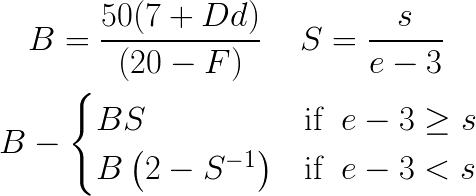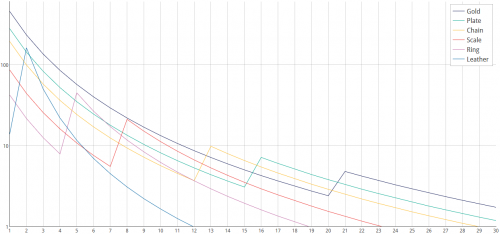Difference between revisions of "Encumbrance rating"
m (→Analysis) |
m (→On Evasion) |
||
| Line 67: | Line 67: | ||
It can be graphed using the second derivative of (armour penalty) + (dodging penalty): | It can be graphed using the second derivative of (armour penalty) + (dodging penalty): | ||
[[File:Diff2StrengthVsEncumbrance.png|thumb|left|500px|The gains in dodge from strength for common body armour.]] | [[File:Diff2StrengthVsEncumbrance.png|thumb|left|500px|The gains in dodge from strength for common body armour.]] | ||
| − | |||
[[File:AdjustedDodgePenaltySecondDerivative.gif]] | [[File:AdjustedDodgePenaltySecondDerivative.gif]] | ||
Revision as of 18:49, 28 June 2023
For shield encumbrance, see Shields. Not to be confused with encumbrance from inventory weight, an obsolete mechanic.
An encumbrance rating is a penalty applied to body armour. The heavier your armour, the higher the encumbrance rating. The higher the encumbrance, the higher the penalty is to evasion, spellcasting, stealth, and ranged weapons. Encumbrance can be mitigated, but not removed, by strength and Armour skill.
Encumbrance rating is exclusive to body armour. Certain other armours may hinder you, but use different mechanics.
- Bardings have a -2 EV penalty. This does not penalize casting, stealth, etc., and cannot be reduced by strength / armour skill.
- Shields also have encumbrance. But this encumbrance is handled entirely differently. See Shields for more details.
See the Table of Armours for numerical details on all items with encumbrance ratings.
Contents
Useful Info
Adjusted body armour penalty
Where e is the encumbrance rating of the armour, S is an arbitrary scale the base is used at for the particular penalty, a is the armour skill of the subject, and s is the strength of the subject.
This penalty is not applied directly, rather it is used in evasion, to hit, and cast chance. For the evasion and cast penalties the scale used is 100. This syntax is the same for the other formula.
Adjusted evasion penalty
This amount is subtracted from your evasion along with other factors such as your size and dodge skill before being stepped down.
Dodging penalty
Where B is the base dodge bonus (formula shown), S is the relationship between strength and encumbrance, d is dodge skill, D is dexterity stepped down if it is above 24, and F is normalized size factor.
This penalty along with the evasion penalty impacts your ability to evade attacks. Due to the change of function when encumbrance nears strength, this penalty makes it a good idea to have a strength equal to or larger than two minus the encumbrance of the armour.
The size factor is normalized around medium size, and can be derived from the following table:
| Size | Size factor |
|---|---|
| Little: Spriggan | 2 |
| Small: Kobold | 1 |
| Medium: Most Races | 0 |
| Large: Troll, Ogre, Palentonga, Naga | -1 |
Stealth penalty
This penalty is subtracted from your stealth score.
Spellcasting penalty
If this added to your shield penalty is positive, then this is added to your failure chance. See spell success for more information.
Ranged Weapon Penalty
This penalty, in aut, is added onto weapon delay to Ranged Weapons (but not Throwing). Divide by 10 to convert to decaAut. A simplified version of this formula can be found in the Ranged Weapons page.
Analysis
On Evasion
Strength generally has a diminishing return on encumbrance. There exists a clear breakpoint, e - 3 > str, where the dodging penalty shifts from 1 equation to another. Therefore, the strength point at (str = e - 2) gives more EV than the points proceeding it. The value decays from there, though the first few strength points after (str = e - 2) tend to be valuable too. Note that it only applies to evasion, not casting or ranged weapons.
This is the basis behind a rule of thumb, where strength should at least be the same number as encumbrance. However, this is not a hard rule. More strength is still likely to have a noticeable impact.
It can be graphed using the second derivative of (armour penalty) + (dodging penalty):
Spreadsheet
See this spreadsheet (and/or make a copy) for an armour penalty calculator: Calculator
History
- Ranged weapon penalities were added in 0.29.
- Armour to-hit penalities were removed in 0.28. Specifically, they were:
- Armour no longer slows down unarmed melee attacks, and some of the mathematics have changed between 0.13 and 0.17.
- Encumbrance ratings were introduced in 0.13, replacing the EV penalty system.





